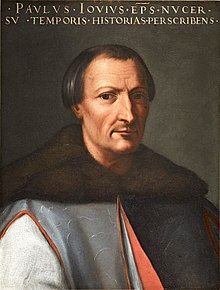Paolo Giovio
Paolo Giovio | |
|---|---|
| Bishop of Nocera de' Pagani | |
 Portrait (1552–1568) | |
| Church | Catholic Church |
| Diocese | Diocese of Nocera de' Pagani |
| In office | 1528–1552 |
| Predecessor | Domenico Giacobazzi |
| Successor | Giulio Giovio |
| Orders | |
| Consecration | 17 Apr 1533 by Gabriele Mascioli Foschi |
| Personal details | |
| Born | 19 April 1483 |
| Died | 11 December 1552 (aged 69) Florence |
Paolo Giovio (also spelled Paulo Jovio; Latin: Paulus Jovius; 19 April 1483 – 11 December 1552)[1] was an Italian physician, historian, biographer, and prelate.
Early life
Little is known about Giovio's youth. He was a native of Como; his family was from the Isola Comacina of Lake Como. His father, a notary, died around 1500. He was educated under the direction of his elder brother Benedetto, a humanist and historian. Although interested in literature, he was sent to Padua to study medicine. He graduated in 1511.
Career
Giovio worked as physician in Como but, after the plague spread in that city he moved to Rome, settling there in 1513. Pope Leo X assigned him a cathedra (chair) of Moral Philosophy and, later, that of Natural Philosophy in the Roman university. He was also knighted by the Pope.[2] In the same period he started to write historical essays. He wrote a memoir of Leo soon after his death.
In 1517, Giovio was appointed as the personal physician for Cardinal
Giovio helped Clement VII during the 1527
In 1536, Giovio had a
Death
In 1549, Pope Paul III denied Giovio the title of Bishop of Como, and he moved to Florence, where he died in 1552.
Works
Giovio is chiefly known as the author of a celebrated work of contemporary history, Historiarum sui temporis libri XLV, of a collection of lives of famous men, Vitae virorum illustrium (1549‑57), and of Elogia virorum bellica virtute illustrium,[4] (Florence, 1554), which may be translated as Praise of Men Illustrious for Courage in War (1554).
Giovio is best remembered as a chronicler of the Italian Wars. In his work, La prima parte dell'historie del suo tempo, Giovio claimed that Italian soldiers were despised following the Leagues' defeat at Fornovo.[5] His eyewitness accounts of many of the battles form one of the most significant primary sources for the period. Many pages of his work are devoted to Skanderbeg.[6]
He is the oldest biographer of Raphael.[7]
Giovio's notable work include:
- De romanis piscibus (1524)
- De legatione Basilii Magni Principis Moschoviae (1525)
- Commentario de le cose de’ Turchi (1531)
- Elogia virorum litteris illustrium or Elogia doctorum virorum (1546)
- Descriptio Britanniae, Scotiae, Hyberniae et Orchadum (1548)
- Vitae (1549)
- Pauli Jovii historiarum sui temporis (1550–52)
- Elogia virorum bellica virtute illustrium (1554), as an eyewitness of many people involved in the Italian Wars including Gonzalo Fernández de Córdoba
- Dialogo dell'imprese militari et amorose (1555)
References
- ^ Thompson Cooper (1873). A New Biographical Dictionary: Containing Concise Notices of Eminent Persons of All Ages and Countries: and More Particularly of ... Great Britain and Ireland. Bell. p. 607.
- ^ Schlager, Patricius (12 July 2013) [1910]. "Paulus Jovius". Catholic Encyclopedia. Vol. 8. New York: Robert Appleton Company.
- ISBN 9781400821839.
- ^ a b Symonds, John Addington (1911). . In Chisholm, Hugh (ed.). Encyclopædia Britannica. Vol. 15 (11th ed.). Cambridge University Press. p. 527.
- ^ Santosuosso 1994, p. 221.
- ^ Comparative literature. 1953. p. 20. Retrieved 2 January 2014.
- ^ Salmi, Mario; Becherucci, Luisa; Marabottini, Alessandro; Tempesti, Anna Forlani; Marchini, Giuseppe; Becatti, Giovanni; Castagnoli, Ferdinando; Golzio, Vincenzo (1969). The Complete Work of Raphael. New York: Reynal and Co., William Morrow and Company. p. 607.
Sources
- Oman, Charles (1937). A History of the Art of War in the Sixteenth Century. London: Methuen & Co.
- Zimmerman, T. C. (1995). Paolo Giovio: The Historian and the Crisis of Sixteenth-Century Italy. Princeton, NJ: Princeton University Press. ISBN 9781400821839.
- Giovio, Paolo (2013). Gouwens, Kenneth (ed.). Notable Men and Women of Our Time. The I Tatti Library. Cambridge, MA: Harvard University Press. ISBN 9780674055056.
- .
In the sixteenth century, Paolo Giovio claimed that the defeat ruined the reputation of Italian soldiers, causing foreigners to despise them and beginning a chain of events which made Italy a servant.
External links
- Schlager, Patricius (1910). . Catholic Encyclopedia. Vol. 8.
- Elogia Doctorum Virorum online (English translation, with life of Paulus Jovius)
- Vita de Leonis X (Latin text)
